What is a Watershed?
Purpose of Watershed Protection
Lake Huron Watersheds
Bi-National Partnership
Contact Us
Home > Pollutants > Invasive Species > Plant Invasives
Curlyleaf Pondweed | Eurasian Watermilfoil | Purple Loosestrife | Phragmites Japanese Knotweed | Garlic Mustard | European Frog-Bit
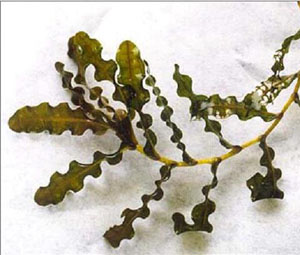 Curlyleaf Pondweed is a rooted perennial plant that grows in shallow water. This species gets its name from its leaves’ wavy sides. The leaves are oblong in shape and dark green with a reddish hue. The small teeth along the edges of its leaves distinguish it from all other species of native Potamogeton in North America. The plant’s stems are flattened and branched, and its flowers are not conspicuous. The species is also known as curly pondweed, curly-leaved pondweed, and crispy-leaved pondweed. Stems grow up to 6 feet (2 m) in length. Leaves are 1-4 inches (2.5-10 cm) long. The plant is native to Eurasia, Africa, and Australia. This species was introduced into the U.S. in the mid-1800s and has since spread across much of the country. It has been planted intentionally for waterfowl and wildlife habitat. Curlyleaf pondweed may spread unintentionally as small plant fragments on boats and equipment that are not properly cleaned, by water used to transport fishes and fish eggs to hatcheries, or possibly by migrating waterfowl. Curlyleaf pondweed is established in most of the continental United States, excluding Maine and South Carolina. It is also present in the Canadian provinces of Alberta, British Columbia, Ontario, Quebec, and Saskatchewan. It was first sighted in the Lake Ontario drainage in 1879. By 1978, it was present across most of the Great Lakes basin. Curlyleaf pondweed grows in quiet, fresh or slightly salty waters. It blooms in late spring and early summer. The plants decay shortly after they bloom, leaving only fruits and buds. The small plants that germinate from the buds in late summer are capable of surviving winter. Growth continues as the water begins warming in spring. Excessive growth of this plant may make it a pest in waterways, lakes, and reservoirs. Curlyleaf pondweed can form dense mats that crowd out and compete with native plants. These mats can also interfere with recreation and access to docks and sport fishing areas. Because curlyleaf pondweed populations usually decline during the summer months, it does not directly compete with many native plant species. Although curlyleaf pondweed is considered a nuisance by many, it has received very little attention compared to other invasive plant species such as Eurasian watermilfoil (Myriophyllum spicatum). Picture: Lake Restoration Incorporated
Curlyleaf Pondweed is a rooted perennial plant that grows in shallow water. This species gets its name from its leaves’ wavy sides. The leaves are oblong in shape and dark green with a reddish hue. The small teeth along the edges of its leaves distinguish it from all other species of native Potamogeton in North America. The plant’s stems are flattened and branched, and its flowers are not conspicuous. The species is also known as curly pondweed, curly-leaved pondweed, and crispy-leaved pondweed. Stems grow up to 6 feet (2 m) in length. Leaves are 1-4 inches (2.5-10 cm) long. The plant is native to Eurasia, Africa, and Australia. This species was introduced into the U.S. in the mid-1800s and has since spread across much of the country. It has been planted intentionally for waterfowl and wildlife habitat. Curlyleaf pondweed may spread unintentionally as small plant fragments on boats and equipment that are not properly cleaned, by water used to transport fishes and fish eggs to hatcheries, or possibly by migrating waterfowl. Curlyleaf pondweed is established in most of the continental United States, excluding Maine and South Carolina. It is also present in the Canadian provinces of Alberta, British Columbia, Ontario, Quebec, and Saskatchewan. It was first sighted in the Lake Ontario drainage in 1879. By 1978, it was present across most of the Great Lakes basin. Curlyleaf pondweed grows in quiet, fresh or slightly salty waters. It blooms in late spring and early summer. The plants decay shortly after they bloom, leaving only fruits and buds. The small plants that germinate from the buds in late summer are capable of surviving winter. Growth continues as the water begins warming in spring. Excessive growth of this plant may make it a pest in waterways, lakes, and reservoirs. Curlyleaf pondweed can form dense mats that crowd out and compete with native plants. These mats can also interfere with recreation and access to docks and sport fishing areas. Because curlyleaf pondweed populations usually decline during the summer months, it does not directly compete with many native plant species. Although curlyleaf pondweed is considered a nuisance by many, it has received very little attention compared to other invasive plant species such as Eurasian watermilfoil (Myriophyllum spicatum). Picture: Lake Restoration Incorporated
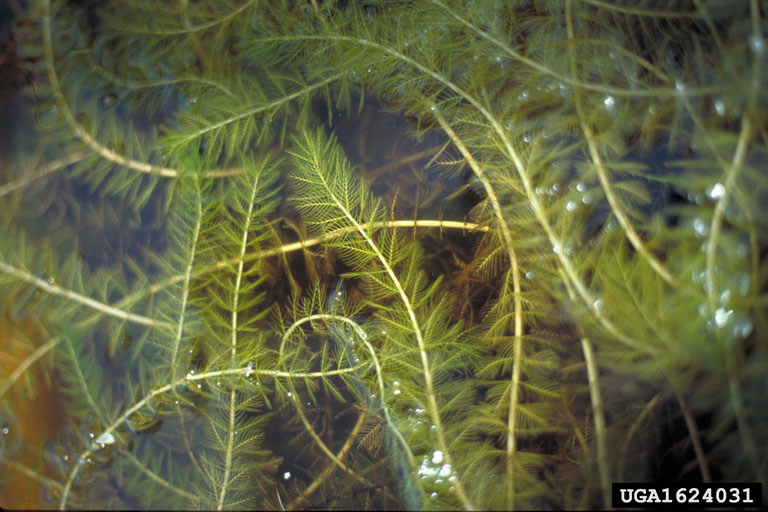 Eurasian Watermilfoil is a plant that grows rooted to the bottom. It has long, underwater stems that branch and produce many leaves upon nearing the surface. The leaves are divided into thread-like leaflets, usually in pairs of more than 12 to 14, forming a feathery shape. Leaflets of the uppermost leaves of Eurasian watermilfoil taper to a squarish tipped leaf. This species can be distinguished from native northern watermilfoil (Myriophyllum sibiricum), whose long leaflets occur in fewer than 11 pairs and extend almost to the leaf tip, resulting in rounded uppermost leaves. In addition, northern watermilfoil tends to grow close to the bottom, while Eurasian watermilfoil grows up to the water surface. Eurasian watermilfoil is an aggressive invader. Its growth displaces and reduces the number of native aquatic plant species. As such, it is now considered a major nuisance throughout the northeast, northern midwest, and Pacific northwest regions of the United States. Its shoots begin to develop in the fall, allowing for earlier growth than other aquatic plants. It quickly grows to the surface, forming dense canopies that shade the surrounding vegetation and restrict the growth of native plants. For example, just two years after the establishment of Eurasian watermilfoil in Lake George, New York, the number of native plant species was reduced from 5.5 to 2.2 species per square yard. Picture: Wisconsin DNR
Eurasian Watermilfoil is a plant that grows rooted to the bottom. It has long, underwater stems that branch and produce many leaves upon nearing the surface. The leaves are divided into thread-like leaflets, usually in pairs of more than 12 to 14, forming a feathery shape. Leaflets of the uppermost leaves of Eurasian watermilfoil taper to a squarish tipped leaf. This species can be distinguished from native northern watermilfoil (Myriophyllum sibiricum), whose long leaflets occur in fewer than 11 pairs and extend almost to the leaf tip, resulting in rounded uppermost leaves. In addition, northern watermilfoil tends to grow close to the bottom, while Eurasian watermilfoil grows up to the water surface. Eurasian watermilfoil is an aggressive invader. Its growth displaces and reduces the number of native aquatic plant species. As such, it is now considered a major nuisance throughout the northeast, northern midwest, and Pacific northwest regions of the United States. Its shoots begin to develop in the fall, allowing for earlier growth than other aquatic plants. It quickly grows to the surface, forming dense canopies that shade the surrounding vegetation and restrict the growth of native plants. For example, just two years after the establishment of Eurasian watermilfoil in Lake George, New York, the number of native plant species was reduced from 5.5 to 2.2 species per square yard. Picture: Wisconsin DNR
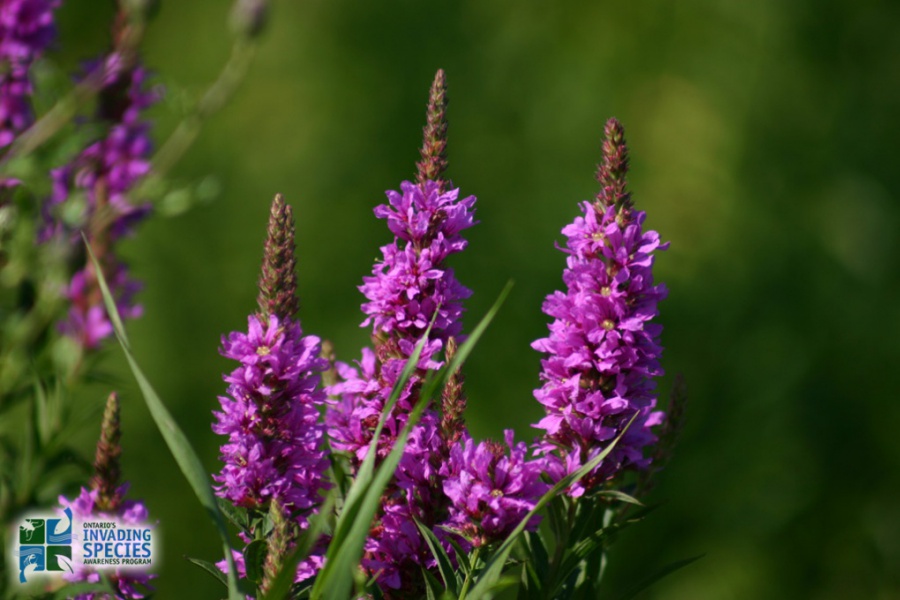 Purple Loosestrife is an upright, perennial plant. It may have up to 50 stems emerging from its base, and its leaves are elongated, have smooth edges, and are fuzzy on their surface. Each plant may have numerous flower spikes made up of many flowers. The flowers are rose-purple and have five to seven petals. Its fruit is smaller than 0.1 of an inch (2 mm) in diameter and is 0.16 of an inch (3-4 mm) long with many small, powdery seeds. The plant is also known as purple lythrum, spiked loosestrife, salicaire, bouquet violet, and rainbow weed. Purple loosestrife has been labeled the “purple plague” because of its widespread devastation to natural communities. The species is included on the Nature Conservancy’s list of “America’s Least Wanted –The Dirty Dozen.” More than thirty states, including Illinois, Indiana, Michigan, Minnesota, Ohio, Pennsylvania and Wisconsin, have passed legislation restricting or prohibiting the plant’s importation and sale.
Purple Loosestrife is an upright, perennial plant. It may have up to 50 stems emerging from its base, and its leaves are elongated, have smooth edges, and are fuzzy on their surface. Each plant may have numerous flower spikes made up of many flowers. The flowers are rose-purple and have five to seven petals. Its fruit is smaller than 0.1 of an inch (2 mm) in diameter and is 0.16 of an inch (3-4 mm) long with many small, powdery seeds. The plant is also known as purple lythrum, spiked loosestrife, salicaire, bouquet violet, and rainbow weed. Purple loosestrife has been labeled the “purple plague” because of its widespread devastation to natural communities. The species is included on the Nature Conservancy’s list of “America’s Least Wanted –The Dirty Dozen.” More than thirty states, including Illinois, Indiana, Michigan, Minnesota, Ohio, Pennsylvania and Wisconsin, have passed legislation restricting or prohibiting the plant’s importation and sale.
Four insect species – a root-mining weevil, two leaf beetles, and a flower-feeding weevil – feed on purple loosestrife and are used to control the plant’s spread. Picture: Ontario's Invading Species Awareness Program
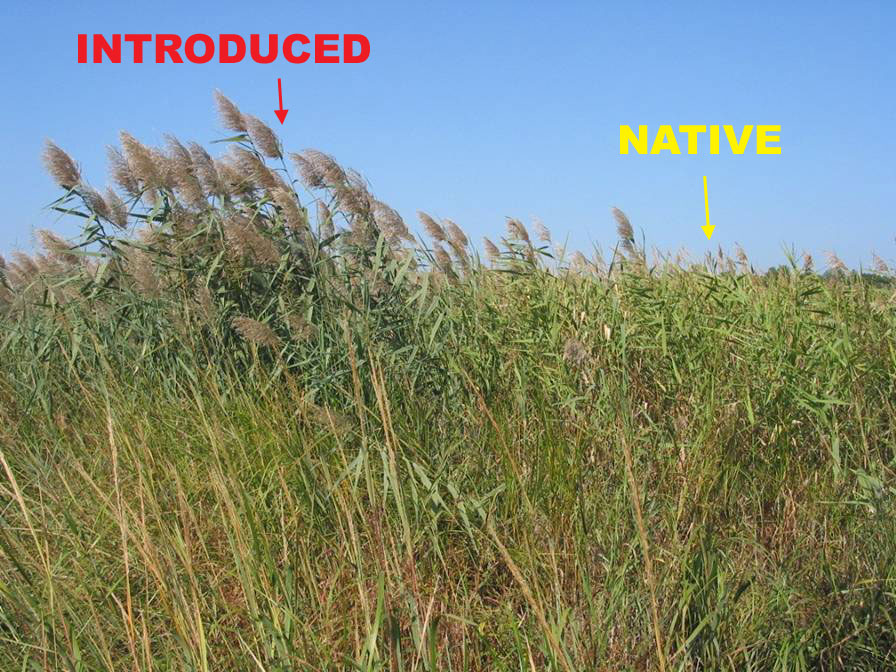 Common Reed, or Phragmites, is a tall, perennial grass that can grow to over 15 feet in height. In North America, both native phragmites (Phragmites australis ssp. americanus Saltonstall, P.M. Peterson & Soreng) and introduced subspecies are found. Introduced Phragmites forms dense stands which include both live stems and standing dead stems from previous year’s growth. Leaves are elongate and typically 1-1.5 inches wide at their widest point. Flowers form bushy panicles in late July and August and are usually purple or golden in color. As seeds mature, the panicles begin to look “fluffy” due to the hairs on the seeds and they take on a grey sheen. Below ground, Phragmites forms a dense network of roots and rhizomes which can go down several feet in depth. The plant spreads horizontally by sending out rhizome runners which can grow 10 or more feet in a single growing season if conditions are optimal. Picture: National Park Service
Common Reed, or Phragmites, is a tall, perennial grass that can grow to over 15 feet in height. In North America, both native phragmites (Phragmites australis ssp. americanus Saltonstall, P.M. Peterson & Soreng) and introduced subspecies are found. Introduced Phragmites forms dense stands which include both live stems and standing dead stems from previous year’s growth. Leaves are elongate and typically 1-1.5 inches wide at their widest point. Flowers form bushy panicles in late July and August and are usually purple or golden in color. As seeds mature, the panicles begin to look “fluffy” due to the hairs on the seeds and they take on a grey sheen. Below ground, Phragmites forms a dense network of roots and rhizomes which can go down several feet in depth. The plant spreads horizontally by sending out rhizome runners which can grow 10 or more feet in a single growing season if conditions are optimal. Picture: National Park Service
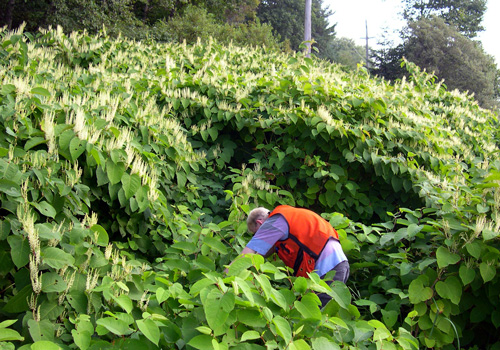 Japanese Knotweed (Polygonum cuspidatum) is a perennial species with spreading rhizomes and numerous reddish-brown, freely branched stems. The plant can reach four to eight feet in height and is often shrubby. The petioled leaves are four to six inches long and generally ovate with an abrupt point. The whitish flowers are borne in open, drooping panicles. The plant is dioecious, so male and female versions of the inconspicuous flowers are produced on separate plants. The approximately 1/8 inch long fruits are brown, shiny, triangular achenes. An escaped ornamental, Japanese knotweed is often found in waste places, neglected gardens, roadsides, and along streambanks. Picture: New York Invasive Species Information
Japanese Knotweed (Polygonum cuspidatum) is a perennial species with spreading rhizomes and numerous reddish-brown, freely branched stems. The plant can reach four to eight feet in height and is often shrubby. The petioled leaves are four to six inches long and generally ovate with an abrupt point. The whitish flowers are borne in open, drooping panicles. The plant is dioecious, so male and female versions of the inconspicuous flowers are produced on separate plants. The approximately 1/8 inch long fruits are brown, shiny, triangular achenes. An escaped ornamental, Japanese knotweed is often found in waste places, neglected gardens, roadsides, and along streambanks. Picture: New York Invasive Species Information
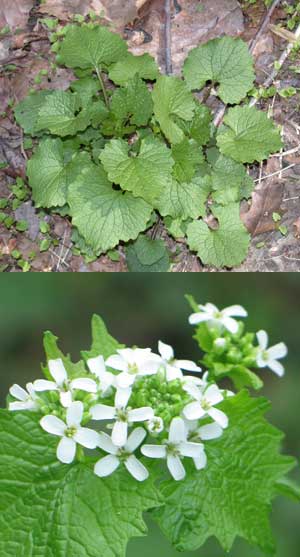 Garlic Mustard is a cool season biennial herb with stalked, triangular to heart-shaped, coarsely toothed leaves that give off an odor of garlic when crushed. First-year plants appear as a rosette of green leaves close to the ground. Rosettes remain green through the winter and develop into mature flowering plants the following spring. Flowering plants of garlic mustard reach from 2 to 3-½ feet in height and produce buttonlike clusters of small white flowers, each with four petals in the shape of a cross. Garlic Mustard poses a severe threat to native plants and animals in forest communities in much of the eastern and midwestern U.S. Many native widlflowers that complete their life cycles in the springtime (e.g., spring beauty, wild ginger, bloodroot, Dutchman's breeches, hepatica, toothworts, and trilliums) occur in the same habitat as garlic mustard. Once introduced to an area, garlic mustard outcompetes native plants by aggressively monopolizing light, moisture, nutrients, soil and space. Wildlife species that depend on these early plants for their foliage, pollen, nectar, fruits, seeds and roots, are deprived of these essential food sources when garlic mustard replaces them. Humans are also deprived of the vibrant display of beautiful spring wildflowers.
Garlic Mustard is a cool season biennial herb with stalked, triangular to heart-shaped, coarsely toothed leaves that give off an odor of garlic when crushed. First-year plants appear as a rosette of green leaves close to the ground. Rosettes remain green through the winter and develop into mature flowering plants the following spring. Flowering plants of garlic mustard reach from 2 to 3-½ feet in height and produce buttonlike clusters of small white flowers, each with four petals in the shape of a cross. Garlic Mustard poses a severe threat to native plants and animals in forest communities in much of the eastern and midwestern U.S. Many native widlflowers that complete their life cycles in the springtime (e.g., spring beauty, wild ginger, bloodroot, Dutchman's breeches, hepatica, toothworts, and trilliums) occur in the same habitat as garlic mustard. Once introduced to an area, garlic mustard outcompetes native plants by aggressively monopolizing light, moisture, nutrients, soil and space. Wildlife species that depend on these early plants for their foliage, pollen, nectar, fruits, seeds and roots, are deprived of these essential food sources when garlic mustard replaces them. Humans are also deprived of the vibrant display of beautiful spring wildflowers.
Picture: National Park Service
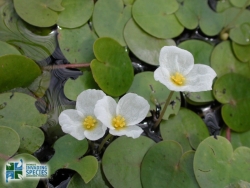 European Frog-Bit is an invasive aquatic plant native to Europe and parts of Asia and Africa. In 1932 the plant was brought from Europe to the Central Experimental Farm in Ottawa for possible commercial use as an ornamental plant. In 1939 it was found in the Rideau Canal. Since then it has spread to several rivers, Lake Ontario, Lake Erie and other inland waters. European frog-bit grows rapidly and forms dense, floating mats. It can be found in slow-moving waters such as sheltered inlets, ponds, slow-running rivers and ditches. Large areas of frog-bit that die in the fall and decompose may lead to reduced oxygen levels in the water that can affect aquatic life. New plants can grow from stem fragments, seeds and winter buds known as turions that can be spread to new waters by boats and wildlife. Picture: Ontario's Invading Species Awareness Program
European Frog-Bit is an invasive aquatic plant native to Europe and parts of Asia and Africa. In 1932 the plant was brought from Europe to the Central Experimental Farm in Ottawa for possible commercial use as an ornamental plant. In 1939 it was found in the Rideau Canal. Since then it has spread to several rivers, Lake Ontario, Lake Erie and other inland waters. European frog-bit grows rapidly and forms dense, floating mats. It can be found in slow-moving waters such as sheltered inlets, ponds, slow-running rivers and ditches. Large areas of frog-bit that die in the fall and decompose may lead to reduced oxygen levels in the water that can affect aquatic life. New plants can grow from stem fragments, seeds and winter buds known as turions that can be spread to new waters by boats and wildlife. Picture: Ontario's Invading Species Awareness Program
Sources: GLANSIS, National Park Service: Alien Plant Invaders, Department of Ecology, State of Washington, Ontario's Invading Species Awareness Program
Northeast Michigan Council of Governments
80 Livingston Blvd. | PO Box 457
Gaylord, MI 49734
(989) 705-3730 | nemcog.org


